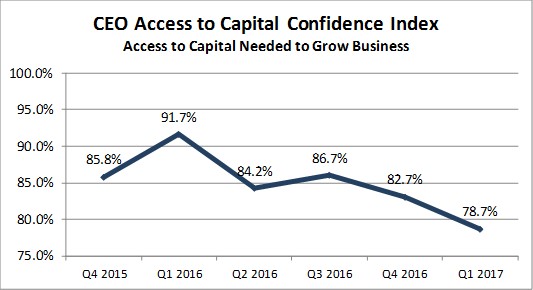Business Lending
Sound Bites From Underwriting – The Risk of Imperfect Merchants
June 12, 2017
When you’re funding a business, does the risk begin and end with the business? Or does the character of the owners play a role? Can you judge the business on weak financials if your product is geared towards weak financials to begin with? And can you trust unaudited internally prepared financial statements?
At the Factoring Conference during a portfolio warning signs panel, Michael Bagley, VP at Action Capital Corporation, spoke about the risk of internally prepared financials:
“The issue is from a financial standpoint, are they breaking even? That gives you some ability they can function, but one thing that jumps out at you is the payables. It really seems pretty simple. But if you’re in an industry where there’s a critical vendor, or you’ve got a critical supplier, or you’ve got subcontractors and the payables are stretched beyond what is logical past terms, well, that’s a huge warning sign in the underwriting, but it didn’t always show up in underwriting, right, because these were internal financials and 90% of the time and they’re garbage, right?
They’re created by the user so that you at some level have to create or mitigate that by creating procedures that allow you to chase down what are your critical expenses associated with customers. So, for example, in the government space, it would be a subcontractor not getting paid. In manufacturing, it could be a critical vendor that you see on the aging. But if you see that their insurance company had not been paid a couple months, it may not be as big a deal.”
Emma Hart, the COO of Sallyport Commercial Finance, on where the risk lies:
“[…] More than anything I would say even beyond the collateral, it’s the integrity of the client that you’re dealing with. Because in my experience, it’s people that pay you back, not businesses.”
Hart again, on judging a customer’s financial situation:
“[…] quite often, that’s the reason they’re factoring, is because their AP is a mess and you can see the AP is a mess and you raise it in the underwriting, you know. Is anybody suing you? What are you gonna do about it? And they’re like ‘Oh, I’m gonna use the money that you provide to me to sort out my AP.’ ‘Okay then.'”
Melissa Baines, Risk Manager of Republic Business Credit, LLC, on a deal going too smoothly:
“We had a situation where I believe they were doing the parking lot striping, the painting on a parking lot. And it was one invoice. It was a dealership. A car dealership was the account debtor. The account executive who was helping out with the take-on sent out the verification letter. The no-offset verification letter came right back. No issues. And our CEO at that time— Again, going back to the gut feeling, just it was too easy— There weren’t even any questions asked. “What is this?” It was just “Sure. Send it over. I’ll sign it.” And he did and we got it back. And so, our CEO called and talked to him. And he said, “Yeah, yeah, yeah, it’s fine. It’s fine.” It still didn’t feel right. So, we called the dealership main line, got the receptionist. She answered the phone. She said, “Who signed it? Okay. Hold on.” Ended up somebody from the accounting department got on the phone and said, “That’s not real. You’re not the first person to call, you know, and then we’ll call you back.” And then ultimately, the owner of the dealership called back and said, “We will take care of this. It will not happen again, but it is not a real invoice. And please do not fund that to that client.” So, you know, don’t ever give up on that gut instinct. There was nothing that said it wasn’t real to begin with, but thank goodness for [employee’s name]. She just had that gut feeling. It wasn’t right. It was too easy. And here you go.”
This is one of several excerpts from this panel that we plan to post under the Sound Bites From Underwriting tagline.
Sound Bites From Underwriting – Gambling With a New Broker
June 9, 2017At the Factoring Conference during a portfolio warning signs panel, Emma Hart, the COO of Sallyport Commercial Finance, was asked if she recalled any red flag situations that hinted at collusion. Whether in factoring or not, you can probably relate to this situation with a new broker:
We had one fairly recently that we should not have funded that the CEO of our business puts on. It was a slow one. We needed the deals. The client was a flour mill supplying flour to Indian restaurants. It was a special type of flour. I can’t remember what it was. He had 4 debtors. The invoices were for $14,500 each. Each of the 4 debtors verified by invoice perfectly and we never heard from him again. And every single one of the debtors claim to have paid him directly. He came to pick up the checks. We don’t even know whether they were valid invoices, whether they even parted with the money, but we never saw him again. And the warning flags were all over the place. They were bright red, weren’t they? It didn’t pass any of the underwriting criteria. The individual was not an individual of good character. He had some history, but the deal had been given to Nick [the company’s president] by a broker. We were establishing a relationship. We always say in our business and every other business, you know, the new sales people get a freebie. Nick doesn’t get any freebies ever anymore, but that was a first funding loss. So, that was a classic first funding loss. It didn’t pass any underwriting criteria. We did it because we were slow. We needed some business. It was a new broker relationship. […] So, that was classic case of collusion, but we should have known better. Absolutely. And he absconded.
This is one of several excerpts from this panel that we plan to post under the Sound Bites From Underwriting tagline.
Industry CEOs Were Less Confident in Q1
June 6, 2017According to the latest quarterly Bryant Park Capital/deBanked survey of industry CEOs, confidence dropped to the lowest levels since the survey first began in Q4 2015. Specifically, confidence in being able to access capital needed to grow dipped down to 78.7% from 82.7% in the prior quarter. Confidence in the continued success of the Small Business Lending & MCA Industry shrank from 81.9% in Q4 to 73.8% in Q1.
See the trends below:


The survey does not ask participants to offer a reason for their confidence but the drop could probably be partially attributed to the events that occurred at CAN Capital, OnDeck’s struggles, and a general correction that took place at several other competing firms.
Sneak Peek of Our May/June 2017 Magazine Issue
June 5, 2017
Move over New York, California and Florida because Texas has become a strong incubator for alternative small business finance. In this newest deBanked magazine issue, we went to Dallas-Fort Worth, Austin and Corpus Christi to find out how and why non-bank financing products are flourishing. We were impressed by what we found and inspired just enough to dub Texas The ‘Loan‘ Star State.
And we went bigger than Texas (if that can be believed) by exploring how alternative lenders are spreading their wings beyond the states into other countries like the UK, Australia and Canada. But does it make sense to go abroad before you’ve cornered the market domestically? Industry captains share their thoughts.
There’s more of course, like how new tweaks to automated processes are actually making manual underwriting exercises easier. That itself has re-opened a debate that won’t seem to go away, humans vs computers in underwriting. In 2017, the humans aren’t out of the game yet and some think they never will be, but there are new tools available to increase speed and efficiency.
There’s legal decisions you’ll want to read and details about a new small business lending regulator you’ll want to know about. It’s all in the May/June 2017 issue that subscribers will be receiving in the mail soon and if you’re not subscribed, you should sign up FREE right now!
Are Small Business Borrowers Bank-Loyal to a Fault?
June 1, 2017 Applying for a small business loan is easier than it’s ever been. Online lenders have streamlined the process, brought it all online and whittled down approval times. Still, the majority of small business owners still think a bank is the only place to get a loan. They’re four times more likely to seek funding from banks than any other source; more than 80 percent of funding applications go to traditional financial institutions.
Applying for a small business loan is easier than it’s ever been. Online lenders have streamlined the process, brought it all online and whittled down approval times. Still, the majority of small business owners still think a bank is the only place to get a loan. They’re four times more likely to seek funding from banks than any other source; more than 80 percent of funding applications go to traditional financial institutions.
Big banks’ small business loan approval rates have dropped sharply thanks to tightened regulations and compliance costs post-Great Recession. Because the transaction costs on a $100,000 loan are roughly the same as a $1,000,000 loan, banks are passing right over small business owners seeking smaller amounts. And since the majority of small businesses want loans smaller than $100,000, they’re not being served by the institutions they turn to first.
Small Business Borrowers Turn to Banks First, But They’re Not as Loyal as They Seem
While it would seem that small business borrowers are loyal to a fault, a Lendio survey of 50,000 business owners found that 74 percent of them would move their account to a new bank if the new bank offered them a loan.
Business owners may be keeping their deposits at banks and turning there first when they set out to obtain funding, but when push comes to shove, they want the easiest path to accessing the capital that will keep their businesses afloat or help them to grow and scale.
Banks Realize They Can’t Rely on Customer Loyalty Alone
Banks have shifted some of their focus back to the small business loan market in the last couple of years. In this space where online lenders have made the process of applying for a loan much more customer-friendly, banks have realized that in order to remain competitive, become more effective and profitable, and ultimately retain customers, they must take a page from the book of online lending.
As little as two years ago, banks were closed off to the idea of outsourcing in the online lending space, while lending firms were armed with technology and ready to compete. Banks have caught on to the idea that investing in a fintech partnership is a quicker, less-expensive way to build technology and create a better customer experience without completely reinventing the wheel, allowing them to serve more of the small business borrowers they’ve been turning away. Now both parties are seeing the value in joining forces.
Recent partnerships in areas such as merchant services, researching, underwriting and accounting software have paved the way for more collaboration between banks and online lenders. Last year we saw banks begin to explore new strategies for converging with online lenders through licensing deals and partnerships, and this year we’ll see even more collaboration in the marketplace.
Partnerships, like JPMorgan Chase’s team-up with online lenders OnDeck and LiftFund, allow banks to leverage technology while expanding their loan offerings and revenue. ScotiaBank, Santander and ING have collaborated with online lender Kabbage to license its technology platform for automating a more efficient underwriting process and to provide more comprehensive lending solutions.
Bank-Alternative Lending Partnerships Are a Win-Win-Win
For banks, the benefits of an alternative lending partnership lie not only in cost savings and tech advances, but also in building and maintaining those loyal customer relationships that have served them for decades. Banks will be able to capture a new generation of customers while also retaining more of their existing customers’ deposits by providing them a better, more streamlined loan application and approval process.
And in such partnerships, online lenders and marketplaces win big too, with access to some of the built-in advantages of a bank: an existing customer base with a high level of trust, risk management experience, access to key data and the ability to offer low-cost capital.
Bank-fintech partnerships offer both parties the opportunity to improve processes and reduce costs. And more importantly, they offer those bank-loyal small business borrowers more options, more efficiently when they turn to the banking institutions they know. When banks and online lenders collaborate to serve small business owners, it’s a win-win-win.
IOU Financial Reports Q1 Results, Lost $1M
May 31, 2017IOU Financial lent (CAD) $22.1 million in the first quarter of this year, down from $25.4 million over the same period last year. This translated into a $995,085 loss on $4.3 million in revenue.
Their quarterly report said that they will continue to focus on achieving profitability in 2017, much like another company in the space. IOU had a net loss of $4.8 million last year.
IOU had previously disclosed that they were in breach with a third party lender, MidCap Financial, over the consolidated tangible net worth covenant of their agreement. IOU has a $50 million credit facility with MidCap, who granted them a waiver on that breach last month in April. Their latest earnings report, however, states that IOU had now also breached the fixed charge coverage ratio covenant, and that MidCap has just granted them another waiver.
MidCap Financial also just recently approved a credit facility for Fundation, an IOU competitor.
Goldman, Cohen Bet on Nav
May 19, 2017
Goldman Sachs. Steve Cohen. These are a couple of the high-profile investors that small business credit and finance startup Nav has attracted to line its coffers. Nav recently lifted the size of a Series B round by $13 million for lead investor Goldman Sachs Principal Strategic Investments as well as Cohen’s Point72 Ventures and others, bringing the tally for this round to $38 million.
Levi King, co-founder and CEO of Nav, told deBanked that Goldman Sachs was drawn to the startup’s robust vision, which is to decrease the death rate of small businesses in the United States. He said doing so would have a trickle up effect on Goldman and the capital markets.
“Goldman Sachs invested as a bank investment, not other people’s money. They believe with scale we will change how small business owners make financial decisions, and that will impact the capital markets. We will have a fundamental impact on the entire ecosystem, if we’re successful.”
Goldman clearly believes it’s a good bet, and Cohen’s Point72 Ventures agrees.
“We have the ability at scale to change what can happen in the capital markets based on our data, and that’s something [Point 72] wants to be a part of. They are a smart advisor for us from a data perspective – a quant hedge fund that’s best in class on data. We get free advice along the way. That’s part of the deal,” King said.
In fact, it was another major player in the credit scene that gave the nod to other investors to follow.
“It all started with Experian. That investment was a bigger landmark than any of the other ones. Experian is the biggest credit agency in the world and they had never done a venture investment until us. This sent a signal to other investors,” said King, referring to a partnership that was inked less than a year ago.
The Vision
King points out that bringing the startup’s vision to reality is a gamble. For instance, Nav’s current customer count is 215,000 and they aspire to have 28 million. “That’s the path that we’re on,” he said. The path includes the startup’s most recent expansion into business checking account data.
“We launched a loan reality check app on Android. We’re only testing it. Nothing like it exists. You put in a username, password and banking information, and we model that data and determine how likely it is that you will qualify for a loan based on that data set,” said King.
For instance, if a business has a history of bouncing checks, that’s a negative for scoring. Depository trends also count toward scoring.
“We’re sitting on personal credit, business credit and checking – three data sets. Now we have enough data for lenders to make full decisions on products like business credit cards,” said King, who makes a clear distinction between the various channels involved in the credit equation.
“To be clear, the small business owner is our customer. Lenders are our partners. Business owners win every time,” he said, pointing to the example of one lender partner.
While King wouldn’t disclose the lender he acknowledged that they are a top-10 financial institution that wanted to pay for a top result for its business credit cards among Nav’s product recommendations. This would have been a sponsored result, but it didn’t sit well with Nav. “It would have been a sweet check, but our product would lose integrity for the customer. We said no,” he said.
Also part of the vision is international expansion. “We have those ambitions. That’s why we’ve taken capital from foreign investors, to see how our model can apply in their markets. But that’s way out there,” he said, pointing to investments by CreditEase Fintech Investment Fund in this most recent round and Tencent in a previous round, both of which are based in China.
Meanwhile King said the fresh capital will be prioritized across three buckets. “We’re pretty disciplined at how we deploy capital. I will tell you what I have repeated thousands of times internally to our business. We spend money on acquiring new customers, improving our technology and UX and compensating our employees. We don’t waste money on in-office massages. At this stage a lot more of that capital goes toward customer acquisition,” he said.
Clocktower Technology Ventures also invested in the most recent Round B. Point72 Ventures and Goldman Sachs did not immediately return calls seeking comment.
Are You a Loan Broker? You Need to Be Licensed in Vermont
May 12, 2017 Loan broker licensing may have gotten stalled in New York, but in Vermont, it’s the law. Governor Phil Scott made H. 182 official on May 4th, regulating everyone engaged in loan solicitation with prospective Vermont borrowers. Specifically this applies to anyone that:
Loan broker licensing may have gotten stalled in New York, but in Vermont, it’s the law. Governor Phil Scott made H. 182 official on May 4th, regulating everyone engaged in loan solicitation with prospective Vermont borrowers. Specifically this applies to anyone that:
- offers, solicits, brokers, directly or indirectly arranges, places, or finds a loan for a prospective Vermont borrower;
- engages in any activity intended to assist a prospective Vermont borrower in obtaining a loan, including lead generation;
- arranges, in whole or in part, a loan through a third party, regardless of whether approval, acceptance, or ratification by the third party is necessary to create a legal obligation for the third party, through any method, including mail, telephone, Internet, or any electronic means;
- or advertises or causes to be advertised in Vermont a loan or any of the services described in (i) –(iii). This license does not include the authority to engage in the business of making loans.
The loan solicitation law is separate from a Commercial Lender License, which already requires licensing to solicit business loans under $1 million, as it covers:
- Any company or person who engages solely in the business of making commercial loans of money, credit, goods, or things in action and charges, contracts for or receives on any such loan interest, a finance charge, discount, or consideration therefore. Commercial loans do not include a loan or extension of credit secured in whole or in part by an owner occupied one-to-four unit dwelling. [Note: The company’s main office must be licensed as a commercial lender prior to, or simultaneously with, the filing of a branch commercial lender license.]
- Each location, whether located in Vermont or not, desiring to engage in the business of making commercial loans in Vermont must obtain a separate license by filing a Form MU3 through the NMLS.
- A commercial loan solicited or made by mail, telephone or electronic means to a Vermont business is subject to licensing notwithstanding where the loan is legally made. No person may engage in the business of soliciting or making commercial loans by mail, telephone or electronic means in Vermont unless duly licensed.
Brokers and lead generators should take a good hard look at their marketing since it may not matter if the customer ultimately is referred to a non-lender such as an equipment lessor or a merchant cash advance company if loans are even an option among many.
According to the law, each loan solicitation licensee shall include clearly and conspicuously in all advertisements of loans and solicitations of leads, the following statement:
“THIS IS A LOAN SOLICITATION ONLY. [INSERT LICENSEE NAME] IS NOT THE LENDER. INFORMATION RECEIVED WILL BE SHARED WITH ONE OR MORE THIRD PARTIES IN CONNECTION WITH YOUR LOAN INQUIRY. THE LENDER MAY NOT BE SUBJECT TO ALL VERMONT LENDING LAWS. THE LENDER MAY BE SUBJECT TO FEDERAL LENDING LAWS.”
A loan solicitation license cost $1,100.00 (includes a $500.00 Licensing Fee, a $500.00 Investigation Fee; and the $100 NMLS processing fee), according to the government website.
If you’re sending mailers to Vermont businesses, calling them or even marketing to them on the Internet, you should speak with an attorney about both the loan solicitation license and commercial lenders license first.





























